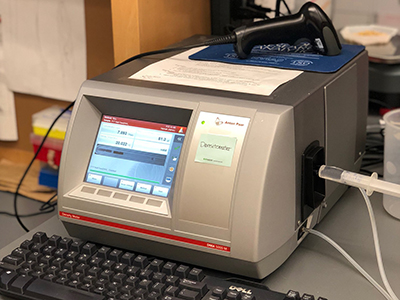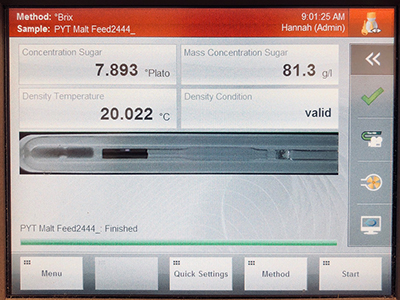Densitometer
MSU Equipment: Anton Paar DMA 5000
The Densitometer determines Extract for both the fine and coarse grind grists
Extract is a measurement of what percentage of the malt becomes solubilized in the mashing process and remains in the wort.
- The higher the extract, the denser the liquid
- The extract is mainly made up of sugars, but also includes soluble proteins, pentosans, minerals and traces of other soluble materials
Check out this sugar experiment to better understand the relationship between density and level of solutes in a liquid.


Anton Paar DMA 5000 densitometer
Densitometer screen showing camera view of internal glass "U-tube"
The densitometer measures density via vibration
- Liquids of different densities will also have different vibrations
- Inside the densitometer is a very fine hand blown glass "U-tube"
- The sample is injected into the tube and it's density is quantified via vibration
- Solute content is correlated to density in the Plato/Brix scale
% Extract is calculated using the malt moisture, grist to water ratio of the wort, and Plato value.
Malt Certificates of Analysis (COA) may report five different variations of extract:
FGDB: Fine Grind dry basis
FG as is: Fine Grind without correction for moisture
CGDB: Coarse Grind dry basis
CG as is: Coarse Grind without correction for moisture
F-C Extract Difference: Fine minus Coarse difference
Fine and Coarse:
This is just referring to which grist the measure was taken on -- fine being more like a flour, course being more like what a brewer would typically mill to. Learn more about lab grists here. Fine grind grists allow a higher extract value as water is ensured to get to all internal parts of the malt. Coarse grists can give a slightly lower value but are more representative of what a brewer would experience.
Dry Basis and "as is":
Reporting extract in dry basis corrects for moisture variation and allows malts to be quickly compared side by side -- it is a way of standardizing the measure. Reporting as is incorporates the moisture variability that may occur malt to malt, but is also more representative to what a brewer would experience as they will be using the malt as is. Learn about how malt moisture is evaluated here.
F-C Difference:
This value provides insight to the level of modifation in the malt. Typically a difference of less than 1-2% is considered an indication that the malt is well modified. From above we said that a fine grind will allow maximum extract because water was able to access all internal parts of the malt. If a malt is well modified water will be able to access all internal parts of the grain even in the coarse grist (this is because grain structures like the cell wall and protein matrix have been degraded during malting). A malt that is undermodified will have less extract in the coarse grist because those structures still exist and prevent water from accessing some of the grains starch.
% Extract is calculated using the malt moisture, grist to water ratio of the wort, and Plato value.
